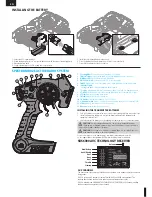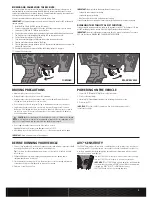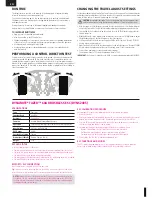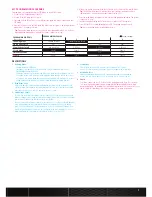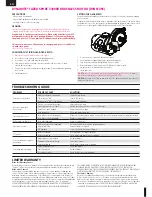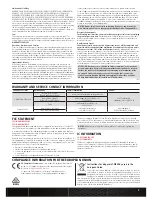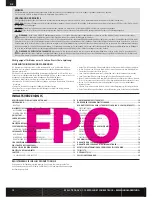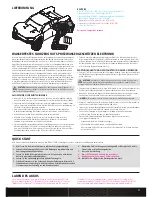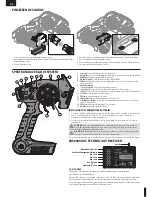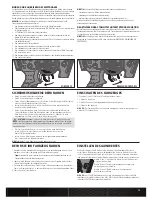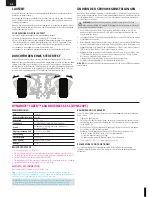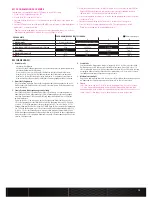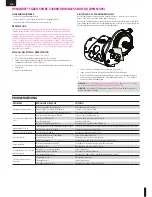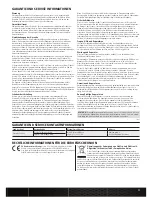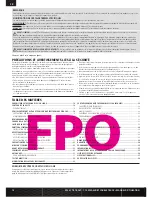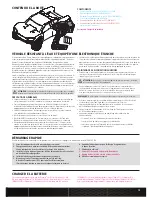
EN
6
44$5353"7$8%4)035$0634&536$,t*/4536$5*0/."/6"-
EN
RUN TIME
The largest factor in run time is the capacity of the battery pack. A larger mAh rating
increases the amount of run time experienced.
The condition of a battery pack is also an important factor in both run time and speed.
The battery connectors may become hot during driving. Batteries will lose performance
and capacity over time.
Driving the vehicle from a stop to full speed repeatedly will damage the batteries
and electronics over time. Sudden acceleration will also lead to shorter run times.
TO IMPROVE RUN TIMES
t
Keep your vehicle clean and well maintained.
t
Allow more airflow to the ESC and motor.
t
Change the gearing to a lower ratio. A lower ratio decreases the operating temperature
of the electronics. Use a smaller pinion gear or larger spur gear to lower the gear ratio.
t
Use a battery pack with a higher mAh rating.
t
Use the optimum charger to charge battery packs (Visit your local hobby dealer for
more information).
PERFORMING A CONTROL DIRECTION TEST
Perform a control test with the vehicle wheels off the ground. If the wheels rotate after the
vehicle is powered ON, adjust the TH Trim knob until they stop. To make the wheels move
forward, pull the trigger. To reverse them, wait for the wheels to stop, then push the trigger.
When moving forward, the wheels should maintain a straight line without any steering wheel
input. If not, adjust the ST Trim knob, so the wheels maintain a straight line without having to
turn the steering wheel.
CHANGING THE TRAVEL ADJUST SETTINGS
Set the travel adjust settings with all four vehicle wheels off the ground. The throttle end point
and brake end point adjustments will cause the wheels to spin at full speed. Have an assistant
safely hold the vehicle securely while adjusting these settings.
CAUTION:
Keep hands, hair and all loose clothing away from any moving parts, espe-
cially the wheels, while setting the travel adjust end points. Serious injury may result.
1. Hold the trigger in the full brake position and turn the steering wheel to Full Right while pow-
ering on the transmitter. The LED flashes rapidly, indicating the programming mode is active.
2. Throttle End Point: Continue holding full throttle. Turn the TH TRIM knob to adjust the full
throttle end point.
3. Brake End Point: Hold the trigger in the full brake position. Turn the TH TRIM knob to adjust
the full brake end point. Return the trigger to the center position.
4. Left Steering End Point: Hold the steering wheel in the full left position. Turn the ST TRIM
knob to adjust the left end point.
5. Right Steering End Point: Hold the steering wheel in the full right position. Turn the ST TRIM
knob to adjust the right end point. Return the steering wheel to the center position.
6. Power off the transmitter to save the travel adjust settings.
The minimum Travel is 75%, and the Maximum travel is 150%.
IMPORTANT:
If the travel is changed on the DX2E, you must rebind and calibrate the SRS6000.
SPECIFICATIONS
Type
Sensorless
Constant/Peak
60A/90A
Resistance
0.0004 Ohm
Function
Forward/Brake–Forward/Brake Reverse
Operation
Proportional forward, proportional reverse with braking delay
Input Voltage
2-3S LiPo, 6-8 Cell NiMH
BEC Output
6V/2A
Overload Protection
Thermal
Dimensions (LxWxH)
40mm x 32mm x 19mm
Weight
51 g
ESC LED STATUS
t
In the neutral position, no LEDs are lit.
t
The red LED lights when the car is moving forward, reversing or braking (sensorless motor).
t
The green LED lights when the car is moving forward, reversing or braking (sensored motor).
t
The red LED flashes if the battery voltage has reached LVC.
t
The red and green LEDs light alternately, indicating the ESC overheating protection is enabled.
t
The red LED lights if the receiver signal is incorrect or missing.
MOTOR TO ESC CONNECTION
Motor wires can be connected to the ESC in any order.
Tip:
If the motor turns in the wrong direction, reverse the connection of the 2 outside motor
wires. The center wire must remain in the center and cannot be moved to another motor tab.
NOTICE:
Always disconnect the battery from the ESC when you have finished operating
your vehicle. The ESC’s switch only controls power to the receiver and servos. The ESC will
continue to draw current when connected to the battery, resulting in possible damage to
the battery through over discharge.
ESC CALIBRATION PROCEDURE
Ensure proper ESC function by calibrating the ESC to your transmitter inputs.
1. Power OFF the ESC.
2. Ensure your transmitter is powered ON, the throttle is not reversed, the throttle trim is neutral
and the throttle travel range is at 100%. Disable any special functions such as ABS, etc.
3. Press the SET button while powering ON the ESC. Release the button as soon as the red
LED starts to flash and the motor emits a beep.
4. Calibrate the throttle points by pressing the SET button once after each step.
- Neutral (1 green flash; 1 beep)—leave the throttle at rest, untouched
- Full throttle (2 green flashes; 2 beeps)—pull the throttle fully back
- Full brake/reverse (3 flashes; 3 beeps)—push the throttle fully forward
5. Power off the ESC. The ESC is calibrated and ready to run.
ESC FUNCTIONS AND MODES
The ESC includes programming options so you can adjust the way your vehicle performs.
Refer to the included settings table to adjust the ESC for your driving conditions.
DYNAMITE
®
TAZER™ 60A BRUSHLESS ESC (DYNS2405)


